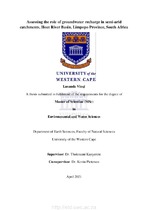| dc.contributor.advisor | Kanyerere, Thokozani | |
| dc.contributor.author | Vinqi, Lusanda | |
| dc.date.accessioned | 2022-01-20T13:37:45Z | |
| dc.date.issued | 2021 | |
| dc.identifier.uri | http://hdl.handle.net/11394/8625 | |
| dc.description | >Magister Scientiae - MSc | en_US |
| dc.description.abstract | Many countries in sub-Sahara African region are characterised by crystalline basement aquifers where groundwater explorations are often described as complex. This is because groundwater availability in such aquifers is largely a consequence of the interaction of several processes related to groundwater process [recharge-flow-discharge process], underlying geological features and fracture connectivity of the aquifer rock matrix. At a local scale, crystalline basement aquifers are heterogeneous and anisotropic due to fractures, geological structures and discontinuities including varying hydraulic characteristics which need to be understood. The lack of detailed investigations of site-specific conditions to assess influence on groundwater recharge process limits implementation of initiatives for groundwater abstraction that supports environment and socio-economic projects. | en_US |
| dc.language.iso | en | en_US |
| dc.publisher | University of the Western Cape | en_US |
| dc.subject | Role of groundwater | en_US |
| dc.subject | Semi-arid catchments | en_US |
| dc.subject | Hout River Basin | en_US |
| dc.subject | Limpopo Province | en_US |
| dc.subject | South Africa | en_US |
| dc.title | Assessing the role of groundwater recharge in semi-arid catchments, Hout River Basin, Limpopo Province, South Africa | en_US |
| dc.rights.holder | University of the Western Cape | en_US |
| dc.description.embargo | 2023 | |

